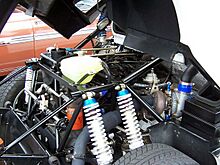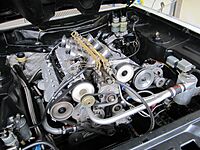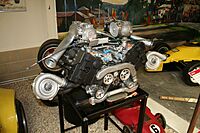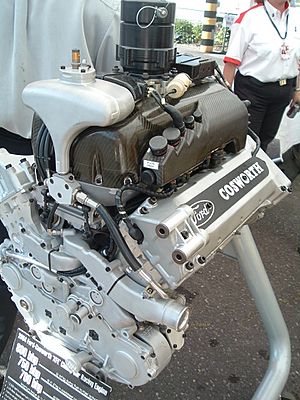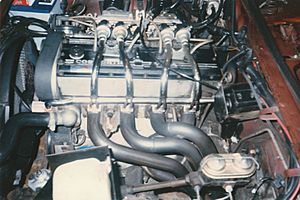Cosworth facts for kids
| Private | |
| Industry | Automotive, automobile racing (motorsport) |
| Founded | 1958 London, England, U.K. |
| Founders | Mike Costin Keith Duckworth |
| Headquarters | Northampton, England |
|
Area served
|
Worldwide |
|
Key people
|
Florian Kamelger |
| Products | Internal combustion engines, electronic data acquisition, and control systems |
| Services | High performance engineering, precision manufacturing |
| Owners | CGH (Isle of Man) Holdings Ltd & Indeck-Cosworth LLC |
| Parent | United Engineering Industries (1980–1990) Vickers plc (1990–1998) Ford (1998–2004) |
| Formula One World Championship career | |
|---|---|
| First entry | 1967 Monaco Grand Prix |
| Last entry | 2013 Brazilian Grand Prix |
| Races entered | 681 |
| Constructors' Championships | 10 (1968, 1969, 1970, 1971, 1972, 1973, 1974, 1978, 1980, 1981) |
| Drivers' Championships |
13 (1968, 1969, 1970, 1971, 1972, 1973, 1974, 1976, 1978, 1980, 1981, 1982, 1994) |
| Race victories | 176 |
| Podiums | 535 |
| Points | 4463.50 |
| Pole positions | 140 |
| Fastest laps | 161 |
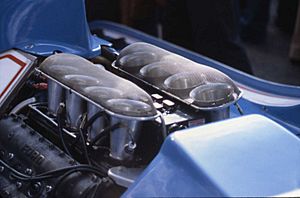
Cosworth is a British company that designs and builds special engines and electronic systems for high-performance cars. They are famous for their work in motorsport and for making powerful engines for regular cars too. Cosworth started in London, England, in 1958. Today, their main base is in Northampton, England, with other locations in the UK and the US.
Cosworth engines have won 176 races in Formula One (F1), which is a huge achievement! They are the third most successful engine supplier in F1 history, right after Ferrari and Mercedes.
Contents
- Cosworth's Story
- Cosworth Engines
- Early Engines
- The SCA Series
- The FVA Series
- The DFV (Double Four Valve) Engine
- The BDA Series
- The GA/GAA V6 Engine
- The FBA and FBC V6 Engines
- The YB Series Engine
- The GBA V6 Engine
- The HB V8 Engine
- The EC, ECA, ED, EDM and ED 2/4 V8 Engines
- The JD, VJ and VJM V10 Engines
- More Formula One Engines
- Other IndyCar and Champ Car Engines
- Other Road Engines
- Cosworth F1 Car
- Cosworth in Formula One: A Summary of Engine Use
- See also
Cosworth's Story
Cosworth was started in 1958 by two friends, Mike Costin and Keith Duckworth. The company name "Cosworth" comes from combining parts of their last names. Both Mike and Keith used to work for a famous car company called Lotus Engineering.
At first, Cosworth worked very closely with Lotus. Most of their early money came from building engines for Lotus cars. Keith Duckworth left Lotus to focus on Cosworth, while Mike Costin stayed at Lotus for a few more years, working on Cosworth projects in his spare time.
Cosworth's first engines were sold only to Lotus. But soon, their engines for Formula Junior races became very popular. This helped Cosworth earn money from other car companies too. They became well-known for their racing engines, especially the Mk.XIII, which was based on the Lotus TwinCam engine. This success allowed Cosworth to focus more on developing powerful racing engines.
In 1966, Cosworth created a new engine design called the FVA. It had a special cylinder head with double overhead camshafts and four valves per cylinder. With help from Lotus founder Colin Chapman, Cosworth convinced Ford to buy the rights to this design. This led to a big partnership, including a deal to develop an eight-cylinder version of the engine. This new engine became the legendary DFV.
For many years, Ford supported Cosworth, and many of Cosworth's engine designs were owned by Ford.
Changes in Ownership
Over the years, Cosworth changed owners several times. In 1980, Keith Duckworth sold his share to United Engineering Industries (UEI), but he still stayed involved in the technical side of the company. UEI was later bought by Carlton Communications in 1988.
Carlton wasn't really interested in engine building, so they looked for a new buyer. In 1990, a traditional engineering company called Vickers plc bought Cosworth.
Then, in 1998, Vickers sold Cosworth to Audi. Audi kept the parts of the company that made engines and castings, calling it Cosworth Technology. They sold the racing engine part, Cosworth Racing, and its electronics division, Pi Research, to Ford. In 2004, Audi sold Cosworth Technology to Mahle GmbH, and it was renamed MAHLE Powertrain.
Later in 2004, Ford sold Cosworth Racing to Gerald Forsythe and Kevin Kalkhoven, who owned the Champ Car World Series. They also bought Pi Research, creating the Cosworth Group.
Since 2006, Cosworth has expanded its work beyond motorsport. They now offer engineering advice, high-performance electronics, and parts manufacturing to other industries. For example, in 2008, the United States Navy hired Cosworth to develop a special engine for their unmanned aerial vehicles (drones).
Cosworth also partnered with Aston Martin to create a super powerful engine for the Aston Martin Valkyrie road car. This engine is a 6.5-litre V12 that makes an incredible 1,000 horsepower!
Cosworth supplied its last top-level racing engines to a Formula One team in 2013, which was the Marussia F1 Team.
Cosworth Engines
Cosworth has made many different types of engines over the years. Here are some of the most famous ones.
Early Engines
Cosworth started by modifying existing Ford Kent engines. They changed the cylinder heads to make them more powerful. Some of their early successful engines were the Mk.XVII and MAE, which had special intake ports for better performance.
| designation | year | block | displacement | claimed power | intended for |
|---|---|---|---|---|---|
| Mk.II | 1960 | 105/107E | 997 cc | 75 bhp | Formula Junior |
| Mk.III | 1960 | 105/107E | 997 cc | 85–90 bhp | Formula Junior |
| Mk.IV | 1961 | 105/107E | 1,098 cc | 90–95 bhp | Formula Junior |
| Mk.XIII | 1963 | 116E | 1,594 cc | 140–150 bhp | Formula B, Lotus 22, 23B, 23C |
| MAE | 1965 | 109E | 997 cc | 100–110 bhp | Formula 3 |
The MAE engine was especially dominant in Formula 3 racing from 1965 to 1968. It was so popular that Cosworth often sold it as a kit because they couldn't build them fast enough!
The SCA Series
In 1964, Cosworth introduced the SCA engine. This was their first engine with a completely new cylinder head designed by Cosworth. It was a 997 cc engine for Formula 2 and had a single overhead camshaft. The SCA engine was very advanced for its time.
It started with 115 horsepower and later reached 140 horsepower with fuel injection. A larger version, the SCB, was used to test new ideas for the FVA engine.
| Type | Year | Block | Displacement | Claimed | Mainly For |
|---|---|---|---|---|---|
| SCA | 1964 | 116E | 997 cc | 115–140 bhp | Formula Two |
| SCB | 1964 | 116E | 1,498 cc | 175 bhp | Development of FVA |
The FVA Series
The FVA (Four Valve Type A) engine was introduced in 1966 for Formula 2 races. It had 16 valves and twin overhead camshafts, which was very advanced. This engine produced about 225 horsepower and dominated its category until 1971. It was also used in sports car racing as the "FVC."
The FVA engine helped Cosworth develop many ideas that were later used in the famous DFV engine.
| Type | Year | Block | Displacement | Claimed | Mainly For |
|---|---|---|---|---|---|
| FVA | 1966 | 116E | 1,598 cc | 218–225 bhp | Formula Two |
| FVC | 1969 | 116E | 1,790 cc | 235 bhp | 2 L sports car racing |
The DFV (Double Four Valve) Engine
In 1966, Colin Chapman, the founder of Lotus, convinced Ford to fund Keith Duckworth's idea for a new, lightweight 3000 cc Formula One engine. This engine became the DFV – which stands for "Double Four Valve."
The DFV engine was a V8 engine and became a legend in motorsport. It won its very first race in 1967 with Jim Clark driving a Lotus 49. From 1968, any F1 team could buy this engine. During the 1970s, almost every F1 team used a DFV engine. It won a record 155 World Championship races, with its last victory in 1983.
Even though the DFV engine (around 410 horsepower) wasn't always the most powerful, it was lighter than other engines. This gave cars a better power-to-weight ratio. Also, it was designed to be a strong part of the car's structure, which was a brilliant idea by Colin Chapman.
As turbocharged engines became popular in F1, the DFV eventually became less competitive. However, it found new life in other racing series like Formula 3000.
DFV Engine Family
The DFV engine led to many other versions:
- The DFW (1968) was a smaller 2500 cc version for the Tasman Series.
- The DFX (1975) was a turbocharged version for IndyCar racing. It dominated IndyCar until the late 1980s.
- The DFL (1982) was designed for endurance racing, winning the 24 Hours of Le Mans twice.
The BDA Series
In 1969, Cosworth strengthened its partnership with Ford by developing the BDA engine. This was a 16-valve, four-cylinder engine for road cars like the Ford Escort. BDA stands for "Belt Drive, A type," because it used a special toothed belt to drive the camshafts.
The BDA engine was very successful in rallying and touring car racing. Different versions were made with larger displacements, like the BDB, BDC, BDE, BDF, and BDG. The BDG even got a new, lighter aluminum engine block.
The BDD and BDM versions were very popular in Formula Atlantic and Formula Pacific races, winning many championships in the 1980s.
In 1981, the turbocharged BDT engine was created, which powered the Ford RS200 rally car. A more powerful version, the BDT-E, made over 600 horsepower!
The BDR was a road version of the BDA, sold as a kit for the Caterham Super Seven sports car.
The GA/GAA V6 Engine
The GA (also called GAA) was a V6 engine based on the Ford Essex V6. It was used in Ford Capri race cars in the early 1970s. This engine had a capacity of 3412 cc and was very competitive, producing around 462 horsepower.
Ford Motorsport also sold 100 of these Cosworth GA V6 engines, and many were used in Formula 5000 race cars. These engines are now very rare and expensive.
The FBA and FBC V6 Engines
The FBA and FBC engines were found in the Ford Granada and Ford Scorpio road cars. The FBA, also known as the 'BOA', was a 24-valve V6 engine that produced 195 horsepower.
In 1995, the FBC (or 'BOB') was introduced, making 204 horsepower. These engines were usually paired with automatic gearboxes but are popular in custom cars where they are often modified to produce around 400 horsepower. They are known for being reliable if well maintained.
The YB Series Engine
The YB series of 1993 cc engines were based on the Ford Pinto engine block. They were first used in the Ford Sierra RS Cosworth road car in 1986, producing 204 horsepower.
The racing versions of the Sierra RS Cosworth were very powerful, making around 370 horsepower. A special version, the Sierra RS500, had a bigger turbocharger and could produce up to 550 horsepower in racing trim.
The RS500 dominated touring car racing from 1987 to 1992, winning many championships and major races around the world. By the end of its racing life, some YB engines were reportedly making around 600 horsepower!
Different versions of the YB engine were identified by the color of their cam covers:
- Red: YBB (Sierra Cosworth 2wd), YBD (Sierra RS500), YBJ (Sierra Sapphire 4wd)
- Green: YBG (catalyst equipped 4x4 Sierra Sapphire Cosworth)
- Blue: YBT (large-turbo Escort Cosworth)
- Silver: YBP (small-turbo Escort Cosworth)
The YB engine was also used in the Ford Escort RS Cosworth. Production of cars with this engine stopped in 1997.
The GBA V6 Engine
Cosworth also designed a completely new turbocharged 1500 cc V6 engine for Formula One, known as the Ford TEC (or internally as the GBA). This engine raced briefly in 1986 with the Haas Lola team and in 1987 with the Benetton team.
The GBA engine was designed by Keith Duckworth and Geoff Goddard. It was the most powerful Formula One engine designed by Cosworth, producing around 900 horsepower.
The HB V8 Engine
The HB series was a new V8 engine designed by Geoff Goddard to replace the older DFV series. It was a 3498 cc V8 and was introduced in 1989 with the Benetton team. It won the Japanese Grand Prix that year.
The HB engine was initially rated at about 630 horsepower. By 1993, the factory version used by Benetton was producing around 700 horsepower. Even though it was less powerful than some V10 and V12 engines from rivals, its advantage was that it was lighter and used less fuel.
A special version of the HB engine was also developed for sports car racing, producing 650 horsepower.
The EC, ECA, ED, EDM and ED 2/4 V8 Engines
The HB engine was further developed into the EC V8 for the 1994 Formula One season. This engine, badged as Ford Zetec-R, produced about 740 horsepower. Michael Schumacher won the Drivers' World Championship with Benetton in 1994 using this engine, which was the last F1 title for a Ford-powered car.
For the 1995 season, F1 engine rules changed to 3 litres. The EC was modified into the ECA, a 2992 cc V8 that produced 600-630 horsepower. It was used exclusively by the Sauber team.
Cosworth also made a customer version called the ED for other teams, which produced about 580 horsepower.
The JD, VJ and VJM V10 Engines
To get even more power, Cosworth designed a completely new 2992 cc V10 engine called the JD for 1996. It produced about 670 horsepower. This engine was further developed into the VJ and VJM versions, reaching 720 horsepower for racing and 730 horsepower for qualifying. These engines were also badged as Ford Zetec-R.
More Formula One Engines
The Stewart Grand Prix team became Ford's main team and used Cosworth CR-1 engines from 1997. These engines were lighter and eventually reached 770 horsepower by 2001. Ford later bought the Stewart team and renamed it Jaguar Racing. Ford left F1 at the end of 2004, but the team (which became Red Bull Racing) continued to use Cosworth V10 engines for a while.
Williams started using Cosworth V8 engines in 2006. These new CA2006 2.4-litre V8 engines produced about 755 horsepower.
Cosworth returned to Formula One in 2010 as an engine supplier for Williams and three new teams: Hispania Racing, Lotus Racing, and Virgin Racing. The CA2010 engine was a re-tuned version of the CA2006, adjusted for the new 18,000 rpm limit. Cosworth continued to supply engines until the end of the 2013 season.
Other IndyCar and Champ Car Engines
Cosworth also designed a series of engines for IndyCar and Champ Car racing, starting with the XB in 1992. The XF was developed for the 2000 season and became the standard engine for the Champ Car World Series in 2003. The latest version, the XFE, was a 2650 cc V8 that produced around 750-800 horsepower.
In 2007, the Ford name was removed from the engine. The Champ Car World Series later merged with the Indy Racing League, and Cosworth no longer supplies engines to American open-wheel racing series.
In 2003, Cosworth provided the 3.5 L V8 XG engine to IRL IndyCar Series teams, badged as a Chevrolet engine. This engine helped teams improve their performance, and it won three races in 2003.
Other Road Engines
Cosworth is well-known in Europe for its partnership with Ford, especially for the high-performance Ford Sierra RS Cosworth and Ford Escort RS Cosworth cars. They also helped create other Ford models like the Escort RS1600 and RS200.
In the US, Cosworth's name appeared on the Chevrolet Vega in the 1970s. Only 3,508 of these cars were made. The engine had a special aluminum cylinder head designed with Cosworth's help.
Cosworth also worked with other car companies like Adam Opel AG (for rally cars like the Opel Ascona 400 and engines in the Opel Kadett and Astra), Mercedes-Benz (for the 190 E 2.3-16), and Audi (for their RS cars).
Cosworth's involvement with Mercedes-Benz began in the mid-1980s when Mercedes wanted to re-enter motorsport. They asked Cosworth to help design a powerful engine for a rally car based on their new 190E model. Cosworth designed the WAA engine, a twin-cam, 16-valve engine. Although the rally car project was cancelled, Mercedes decided to sell the car as a high-performance road sedan. Cosworth detuned the WAA engine to 185 horsepower for the road version.
More recently, in 2020, Gordon Murray Automotive asked Cosworth to design a 3994 cc V12 engine for their new T.50 sports car. This engine produces 663 horsepower!
Cosworth was also chosen by Bugatti to develop a V16 engine for their upcoming Bugatti Tourbillon hybrid car. This engine is expected to produce 1,000 horsepower.
Cosworth F1 Car
In 1969, Cosworth even tried to design its own Formula One Grand Prix car. The car had a special four-wheel-drive system designed by Keith Duckworth and was powered by a lightweight version of the DFV engine. However, the project was eventually cancelled.
Cosworth in Formula One: A Summary of Engine Use
| Season | Engine | Type | Disp. | Teams | Wins | Notes |
|---|---|---|---|---|---|---|
| 1963 | Mk.IX | I4 | 1.5 | Lotus | 0 |
|
| 1964 | Mk.XVI | I4 | 1.5 | Cooper | 0 |
|
| 1965 | Mk.XVI | I4 | 1.5 | Lotus, Cooper | 0 |
|
| 1966 | SCA | I4 | 1.0 | Brabham, Lotus, Matra | 0 |
|
| 1967 | FVA | I4 | 1.6 | Brabham, Lola, Lotus, Matra, Protos | 4 |
|
| DFV | V8 | 3.0 | Lotus | |||
| 1968 | DFV | V8 | 3.0 | Lotus, McLaren, Matra | 11 |
|
| FVA | I4 | 1.6 | Matra | |||
| 1969 | DFV | V8 | 3.0 | Matra, Brabham, Lotus, McLaren | 11 |
|
| FVA | I4 | 1.6 | Brabham, Lotus, Matra, Tecno | |||
| 1970 | DFV | V8 | 3.0 | Lotus, March, McLaren, Brabham, Surtees, Tyrrell, Bellasi, De Tomaso | 8 |
|
| 1971 | DFV | V8 | 3.0 | Tyrrell, March, Lotus, McLaren, Surtees, Brabham, Bellasi | 7 |
|
| 1972 | DFV | V8 | 3.0 | McLaren, Lotus, Tyrrell, Surtees, March, Brabham, Poiltoys, Connew | 10 |
|
| 1973 | DFV | V8 | 3.0 | Lotus, Tyrrell, McLaren, Brabham, March, Shadow, Surtees, Iso–Marlboro, Ensign | 15 |
|
| 1974 | DFV | V8 | 3.0 | McLaren, Tyrrell, Lotus, Brabham, Hesketh, Shadow, March, Iso–Marlboro, Surtees, Lola, Token, Trojan, Penske, Parnelli, Lyncar, Ensign, Amon, Maki | 12 |
|
| 1975 | DFV | V8 | 3.0 | McLaren, Brabham, Hesketh, Tyrrell, Shadow, March, Lotus, Williams, Parnelli, Hill, Penske, Ensign, Fittipaldi, Lyncar, Lola, Maki, Surtees | 8 |
|
| 1976 | DFV | V8 | 3.0 | Tyrrell, McLaren, Lotus, Penske, March, Shadow, Surtees, Fittipaldi, Ensign, Parnelli, Wolf–Williams, Williams, Kojima, Hesketh, Maki, Brabham, Boro | 10 |
|
| 1977 | DFV | V8 | 3.0 | Lotus, McLaren, Wolf, Tyrrell, Shadow, Fittipaldi, Ensign, Surtees, Penske, Williams, Boro, LEC, McGuire, Kojima, Hesketh, March | 12 | |
| 1978 | DFV | V8 | 3.0 | Lotus, Tyrrell, Wolf, Fittipaldi, McLaren, Arrows, Williams, Shadow, Surtees, Ensign, Martini, Hesketh, ATS, Theodore, Merzario, March | 9 |
|
| 1979 | DFV | V8 | 3.0 | Williams, Ligier, Lotus, Tyrrell, McLaren, Arrows, Shadow, ATS, Fittipaldi, Kauhsen, Wolf, Brabham, Ensign, Rebaque, Merzario | 8 |
|
| 1980 | DFV | V8 | 3.0 | Williams, Ligier, Brabham, Lotus, Tyrrell, McLaren, Arrows, Fittipaldi, Shadow, ATS, Osella, Ensign | 11 |
|
| 1981 | DFV | V8 | 3.0 | Williams, Brabham, McLaren, Lotus, Tyrrell, Arrows, Ensign, Theodore, ATS, Fittipaldi, Osella, March | 8 |
|
| 1982 | DFV | V8 | 3.0 | McLaren, Williams, Lotus, Tyrrell, Brabham, Arrows, ATS, Osella, Fittipaldi, March, Theodore, Ensign | 8 |
|
| 1983 | DFY | V8 | 3.0 | Williams, McLaren, Tyrrell | 3 |
|
| DFV | V8 | 3.0 | Williams, McLaren, Tyrrell, Arrows, Lotus, Theodore, Osella, RAM, Ligier | |||
| 1984 | DFY | V8 | 3.0 | Tyrrell | 0 | |
| DFV | V8 | 3.0 | Arrows, Spirit | |||
| 1985 | DFY | V8 | 3.0 | Tyrrell | 0 | |
| DFV | V8 | 3.0 | Minardi | |||
| 1986 | GBA | V6-T | 1.5 | Haas Lola | 0 |
|
| 1987 | GBA | V6-T | 1.5 | Benetton | 0 |
|
| DFZ | V8 | 3.5 | Tyrrell, Larrousse, AGS, March, Coloni | |||
| 1988 | DFR | V8 | 3.5 | Benetton | 0 |
|
| DFZ | V8 | 3.5 | Tyrrell, Rial, Minardi, Coloni, Larrousse, AGS, EuroBrun, Dallara | |||
| DFV | V8 | 3.0 | Dallara | |||
| 1989 | HB | V8 | 3.5 | Benetton | 1 |
|
| DFR | V8 | 3.5 | Benetton, Tyrrell, Arrows, Dallara, Minardi, Onyx, Ligier, Rial, AGS, Osella, Coloni | |||
| 1990 | HB | V8 | 3.5 | Benetton | 2 | |
| DFR | V8 | 3.5 | Tyrrell, Arrows, Monteverdi, Ligier, Osella, Dallara, Coloni, AGS, Minardi | |||
| 1991 | HB | V8 | 3.5 | Benetton, Jordan | 1 |
|
| DFR | V8 | 3.5 | Lola, Fondmetal, Coloni, AGS, Footwork | |||
| 1992 | HB | V8 | 3.5 | Benetton, Lotus, Fondmetal | 1 |
|
| 1993 | HB | V8 | 3.5 | McLaren, Benetton, Lotus, Minardi | 6 | |
| 1994 | EC Zetec-R | V8 | 3.5 | Benetton | 8 |
|
| HB | V8 | 3.5 | Footwork, Minardi, Larrousse, Simtek | |||
| 1995 | ECA Zetec-R | V8 | 3.0 | Sauber | 0 |
|
| ED | V8 | 3.0 | Minardi, Forti, Simtek, Pacific | |||
| 1996 | JD Zetec-R | V10 | 3.0 | Sauber | 0 |
|
| ECA Zetec-R | V8 | 3.0 | Forti | |||
| ED | V8 | 3.0 | Minardi | |||
| 1997 | VJ Zetec-R | V10 | 3.0 | Stewart | 0 | |
| ECA Zetec-R | V8 | 3.0 | Lola | |||
| ED | V8 | 3.0 | Tyrrell | |||
| 1998 | VJ Zetec-R | V10 | 3.0 | Stewart | 0 | |
| JD Zetec-R | V10 | 3.0 | Tyrrell, Minardi | |||
| 1999 | CR-1 | V10 | 3.0 | Stewart | 1 | |
| VJ Zetec-R | V10 | 3.0 | Minardi | |||
| 2000 | CR-2 | V10 | 3.0 | Jaguar | 0 |
|
| VJ Zetec-R | V10 | 3.0 | Minardi | |||
| 2001 | CR-3 | V10 | 3.0 | Jaguar | 0 |
|
| VJ Zetec-R | V10 | 3.0 | Minardi | |||
| 2002 | CR-4 | V10 | 3.0 | Jaguar, Arrows | 0 | |
| CR-3 | V10 | 3.0 | Jaguar, Arrows | |||
| 2003 | CR-5 | V10 | 3.0 | Jaguar | 1 |
|
| RS1 | V10 | 3.0 | Jordan | |||
| CR-3 | V10 | 3.0 | Minardi | |||
| 2004 | CR-6 | V10 | 3.0 | Jaguar | 0 |
|
| RS2 | V10 | 3.0 | Jordan | |||
| CR-3L | V10 | 3.0 | Minardi | |||
| 2005 | TJ2005 | V10 | 3.0 | Red Bull, Minardi | 0 |
|
| 2006 | CA2006 | V8 | 2.4 | Williams | 0 |
|
| TJ2005 | V10 | 3.0 | Toro Rosso | |||
| 2007–2009: Cosworth did not supply any engines in Formula One. | ||||||
| 2010 | CA2010 | V8 | 2.4 | Williams, Lotus, HRT, Virgin | 0 | |
| 2011 | CA2011 | V8 | 2.4 | Williams, HRT, Virgin | 0 | |
| 2012 | CA2012 | V8 | 2.4 | HRT, Marussia | 0 | |
| 2013 | CA2013 | V8 | 2.4 | Marussia | 0 | |
| 2014–present: Cosworth has not been supplying any engines in Formula One. | ||||||
See also
 In Spanish: Cosworth para niños
In Spanish: Cosworth para niños
- Marcos Engineering
- MAHLE Powertrain






